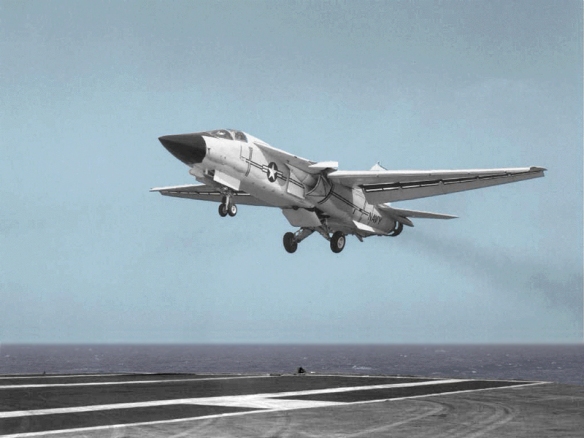A General Dynamics F-111B (BuNo 151974) approaching the aircraft carrier USS Coral Sea (CVA-43) in July 1968. It was the only F-111B to perform carrier operations after completing arrestor proving tests at the Naval Air Test Center Patuxent River, Maryland (USA), in February 1968. It crash landed at NAS Point Mugu, California (USA), on 11 October 1968 and was subsequently scrapped.
There are five cases of adaptation or attempted adaptation of land-based designs to meet USN needs for carrier-based aircraft: North American FJ-2 through FJ-4 series, General Dynamics F-111B, McDonnell-Douglas F/A-18A and B, McDonnell-Douglas T-45A Goshawk, and Lockheed Martin F-35B. Each presents a somewhat different picture. The FJ-2 was an adaptation of the F-86E. However, the F-86 model had its origins in the naval FJ-1, whose legacy had ensured many points of carrier compatibility and greatly eased the adaptation.
Although the F-111 was developed with the intention that it would be manufactured in both land- and carrier-based versions, the mission requirements for the land-based version were such as to make it all but impossible to achieve either satisfactory carrier suitability characteristics or conformance with Navy mission requirements. Thus the F-111B (carrier) version did not proceed.
The F-111B incorporated innovations such as variable-geometry wings, afterburning turbofan engines, and the long-range AWG-9/AIM-54 Phoenix weapons system.
Designed in parallel with the F-111 “Aardvark”, which was adopted by the Air Force as a strike aircraft, the F-111B suffered development issues and changing Navy requirements for an aircraft with maneuverability for dogfighting. The F-111B was not ordered into production and the F-111B prototypes were used for testing before being retired. The F-111B would be replaced by the smaller and lighter Grumman F-14 Tomcat, which carried over the engines, AWG-9/Phoenix weapons system, and similar swing-wing configuration.
The weight goals for both F-111 versions proved to be overly optimistic. Excessive weight plagued the F-111B throughout its development. The prototypes were far over the requirement weight. Design efforts reduced airframe weight but were offset by the addition of the escape capsule. The additional weight made the aircraft underpowered. Lift was improved by changes to wing control surfaces. A higher thrust version of the engine was planned.
Requirements for the F-111B had been formulated before air combat over Vietnam in 1965 showed the Navy had a need for an aircraft which could engage fighters at close range. The Navy desired a fighter with more performance than the F-4 Phantom II, yet in trials, the maneuverability and performance of the F-111B was decidedly inferior to the Phantom.[citation needed] During the congressional hearings for the aircraft, Vice Admiral Thomas F. Connolly, then Deputy Chief of Naval Operations for Air Warfare, responded to a question from Senator John C. Stennis as to whether a more powerful engine would cure the aircraft’s woes, saying, “There isn’t enough power in all Christendom to make that airplane what we want!”
With the F-111B program in distress, Grumman began studying improvements and alternatives. In 1966 the Navy awarded Grumman a contract to begin studying advanced fighter designs. Grumman narrowed down these designs to its Model 303 design. With this the F-111B’s end appeared near by mid- 1967. By May 1968 both Armed Services committees of Congress voted not to fund production and in July 1968 the DoD ordered work stopped on F-111B. A total of seven F-111Bs were delivered by February 1969.
The F-111B’s replacement, the Grumman F-14 Tomcat, which derived from Grumman’s initial Model 303 design, reused the TF30 engines from the F-111B, though the Navy planned on replacing them with an improved engine later. Although lighter than the F-111B, it was still the largest and heaviest U.S. fighter to takeoff and land from an aircraft carrier. Its size was a consequence of the requirement to carry the large AWG-9 radar and AIM-54 Phoenix missiles, both from the F-111B, while exceeding the F-4’s maneuverability. While the F-111B was armed only for the interceptor role, the Tomcat incorporated an internal M61 Vulcan cannon, provisions for Sidewinder and Sparrow air-to air missiles, and provisions for bombs.
Specifications (F-111B pre-production)
General characteristics
Crew: 2 (pilot and weapons system operator)
Length: 68 ft 10 in (20.98 m)
Wingspan:
Spread: 70 ft (21.3 m)
Swept: 33 ft 11 in (10.34 m)
Height: 15 ft 9 in (4.80 m)
Wing area:
Spread: 655.5 ft² (60.9 m²)
Swept: 550 ft² (51.1 m²)
Airfoil: NACA 64-210.68 root, NACA 64-209.80 tip
Empty weight: 46,100 lb (20,910 kg)
Loaded weight: 79,000 lb (35,800 kg)
Max. takeoff weight: 88,000 lb (39,900 kg)
Powerplant: 2 × Pratt & Whitney TF30-P-3 turbofans
Dry thrust: 10,750 lbf (47.8 kN) each
Thrust with afterburner: 18,500 lbf (82.3 kN) each
Performance
Maximum speed: Mach 2.2 (1,450 mph, 2,330 km/h)
Range: 2,100 mi (1,830 nmi, 3,390 km); with 6 AIM-54 missiles and 23,000 lb fuel internal
Ferry range: 3,200 mi(2,780 nmi, 5,150 km); with 2 x 450 gal external tanks
Service ceiling: 65,000 ft (19,800 m)
Rate of climb: 21,300 ft/min (108 m/s)
Wing loading:
Spread: 120 lb/ft² (586 kg/m²)
Swept: 144 lb/ft² (703 kg/m²)
Thrust/weight: 0.47
Armament
Guns: 1× M61 Vulcan 20 mm (0.787 in) Gatling cannon (seldom fitted)
Hardpoints: 6 underwing pylons for ordnance and external fuel tanks
Missiles: 6 x AIM-54 Phoenix long range air-air missiles
Avionics
AN/AWG-9 Pulse-Doppler radar
